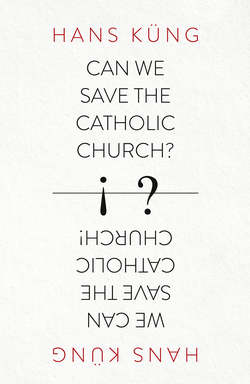Читать книгу Can We Save the Catholic Church? - Hans Kung - Страница 10
The Church Cannot Go On in This Way
Оглавление‘Things just can’t go on like this in our Church’; ‘The powers that be, those up there in Rome, are doing their best to tear the Church apart!’ Complaints like these, and similarly bitter, outraged or despairing cries have frequently been heard over the past few years, in both Europe and the United States.
As Alois Glück, the clear-sighted and courageous chairman of the Central Committee of German Catholics, put it after the Second Ecumenical Church Congress in Munich back in May 2010:
The alternatives are either resignation, accompanied by a deliberate shrinking of the Church until it consists of only a small community of ‘staunch Christians’ as some have little or no regrets about doing, or getting up the courage and determination to try something new.
His words expressed the concerns and hopes of many Catholics, especially the most dedicated and highly motivated members of the Church. The response of the bishops, however, was slow and reluctant; many clearly wanted to continue as before. And that explains the frustration, the anger and the despair that is particularly strong among the most loyal Catholics, who have not yet forgotten the Second Vatican Council.
The Catholic Church is in its deepest crisis of confidence since the Reformation, and nobody can overlook it. As Pope Benedict XVI, Joseph Ratzinger missed a great opportunity to make the forward-looking ideas of the Second Vatican Council the lodestone of the Catholic Church worldwide and especially within the Vatican itself. Instead of courageously pushing forward the reforms begun by the Council, he did the opposite: again and again, he qualified and weakened the statements of the Council, interpreting them retrogressively, contrary to the spirit of the Council fathers. He even expressly set his face against Vatican II, which, as an ecumenical council, represents, according to the great Catholic tradition, the highest authority within the Catholic Church. He did this by:
• accepting, without any preconditions, the illegally ordained bishops from the traditionalist Pius X Fraternity, which has separated itself from the Catholic Church and which continues to reject central elements of the Council’s teaching;
• actively promoting the use of the Medieval Tridentine Mass and, on occasion, celebrating the Eucharist himself in Latin with his back to the congregation;
• creating a deep mistrust of the Protestant churches by continuing to insist that they do not constitute ‘Churches’ in the true sense of the word;
• failing to pursue the paths to understanding and communication with the Anglican Church as outlined in official (ARCIC) ecumenical documents, attempting instead to lure conservative married Anglican clergymen into the Roman Catholic Church by waiving their obligation to celibacy; and
• strengthening the forces opposing the Second Vatican Council within the Church by appointing men who are opposed to the Council to important administrative positions (e.g. the Secretariat of State, Congregation for Divine Worship and the Discipline of the Sacraments, and the Congregation of Bishops) and installing reactionary bishops around the world.
Benedict XVI’s now-notorious faux pas made it clear that Pope Ratzinger was becoming increasingly distant from the great majority of churchgoers and believers in our countries, many of whom pay increasingly little attention to pronouncements from Rome. At best, these churchgoers relate to their local parish, their pastor and possibly their local bishop. Benedict’s courageous decision, in February 2013, to resign his office deserves our full respect, but it was motivated explicitly for reasons of health; it is not an acknowledgement of mistakes made in the past or a call to take a different course in the future. Thus, of itself, Benedict’s resignation changed nothing, and everything will depend on the course steered by his successor, Pope Francis.
In implementing his anti-Council policies, Benedict XVI, like his own predecessor, enjoyed the full support of the Roman Curia, a Curia in which those persons who support the Council have long since been isolated or eliminated. In the years that have passed since the Council, a highly efficient propaganda machine has been set up to serve the Roman cult of personality. Modern mass media (television, the internet, YouTube and now Twitter) are being used systematically, professionally and successfully to promote the vested interests of the Curia. When you watch the huge Masses at the Vatican, or the gatherings surrounding papal visits and journeys, you could be excused for believing that all is in order in the Catholic Church. But the question we must ask is: what is the substance behind this glittering façade? On the local level, things look quite different.
